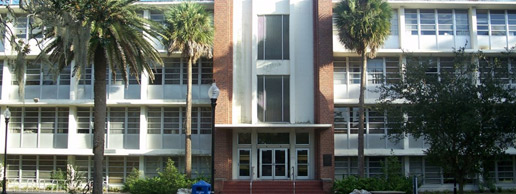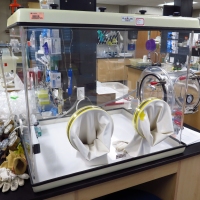Our Facilities
-
McCarty Hall A

On the UF campus you'll find our lab and offices on the third-floor of McCarty Hall-A. The third floor was renovated in 2012 making it a state of the art facility. The main office and other members of the Soil and Water Sciences Department are also in McCarty A, on the ground and second floors.
-
Main Laboratory

This is where it all (or most of it) happens. You can generally find at least one or two students at work here. Located on the 3rd floor of McCarty Hall-A, the lab is more than 800 square feet including three sinks, a 6-ft fume hood, and more than 110 feet of bench space.
Equipment: a large volume benchtop centrifuge, vacuum filtration station, a gas purging station, nano-pure water source, an anaerobic glove box, two temperature/light/CO2-controlled growth chambers, and our membrane-inlet mass spectrometer.
-
Core Instrumentation Lab
Coming soon
-
Stable Isotope Facility

Isotope Ratio Mass Spectrometer
The Stable Isotope Mass Spectrometry Facility is housed and staffed within the Soil and Water Sciences Department (SWSD). The instrumentation was purchased and is maintained as a collaborative research facility by the SWSD, and UF Departments of Geological Sciences and Botany. Samples from other UF Departments as well as other outside entities can be submitted to the facility and current pricing can be obtained by contacting Dr. Kathryn Curtis.
The centerpiece of the facility is a Thermo Finnigan MAT Delta Plus XL mass spectrometer configured to measure stable isotope ratios of certain gases (especially CO2, N2, and N2O). Three peripherals are presently dedicated to the mass spectrometer for the purpose of delivering gas samples to the mass spectrometer:
Elemental Analyzer (EA-IRMS)- A Costech Instruments elemental combustion system (ECS4010) is connected to the mass spectrometer for the purpose of flash combustion of soil, plant, and tissue samples to produce N2 and CO2. UHP Helium is used as a carrier gas to transport the gases produced during combustion thru a water trap to remove any water present in the gas stream prior to entering a GC column within the system where the N2 and CO2 are separated within the carrier gas before delivery through a ConFlo III interface to the mass spectrometer.
Gas Chromatograph (GC-C-IRMS)- A modified Hewlett Packard HP 6890 is utilized for carbon isotope analysis via Isotope-Ratio-Monitoring Gas Chromatography (GC-C-IRMS). The GC-C-IRMS technique involves on-line separation of compounds (e.g. amino acids, FAMES, sterols and other hydrocarbons) from mixtures by gas chromatography. The gas chromatography effluents are combusted to CO2 and sent to the mass spectrometer continuously in a helium carrier stream
Gas Bench- A Thermo Finnigan GasBench III is used to measure gas samples in individual septa top vials. Utilizing a CTC GC-PAL autosampler a double needle system takes headspace gas from sample vials and performs multiple isotopic analysis. The GasBench system is primarily used for measuring gaseous CO2 from atmosphere, soil respiration, and dissolved inorganic carbon in water. It is also used to measure N2O converted from nitrate via the microbial denitrifier method.
-
Newell Hall
 This might be more of a history lesson now, but this is the original Florida Experiment Station where the Land Grant Mission at the University of Florida began. It is also where our research program began back in 2007. Needless to say this building from 1910 (remodeled in the 1950's) was less than state of the art, but we managed to live and do some quality work here until we 'moved on up' to McCarty Hall.
This might be more of a history lesson now, but this is the original Florida Experiment Station where the Land Grant Mission at the University of Florida began. It is also where our research program began back in 2007. Needless to say this building from 1910 (remodeled in the 1950's) was less than state of the art, but we managed to live and do some quality work here until we 'moved on up' to McCarty Hall.The university has decided to renovate this building as a student study hall (I think that's code language for another Starbucks and a lot of couches). I will miss the good times and people, being able to park right by the building, and the storage space with 16-foot ceilings. But I certainly will not miss the leaking roof, lack of fume hoods, and emergency evacuations because the elevator caught on fire again.
-
Greenhouse and Mesocosms
Coming soon
